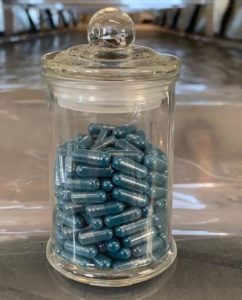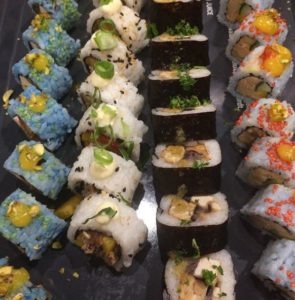Going back to life’s drawing board… and tapping into its initial building blocks. That’s how these two agri-foodtech startups in GROW Accelerator’s latest cohort founded their cell-focused businesses. GROW is AgFunder’s Singapore-based accelerator in partnership with Rocket Seeder.
Back of the Yards algae sciences (BYAS) taps into the potential of one of the very first single-celled living things on Earth – algae. It was, and still is, one of the most abundant food sources for hundreds of animal species. The Chicago-based startup wants to bring back algae to become the bedrock of a sustainable, largely plant-based food industry. It’s currently focusing on producing protein-rich food as an alternative to meat.
“On average, our products are made up of 50%-75% protein. That means we can meet 50% of your daily protein needs with just a few drops of our product in a simple glass of water,” says Rob Agterberg, partner of BYAS.
Meanwhile, SinGENE delves deeper into cell DNA to create a platform for microbial food contamination detection & analysis. The Singapore-based company wants to tailor its platform – which can discern anything that contains DNA – to large scale clients, eyeing governmental bodies and big corporates.
“GROW helped us to get more connections with industrial customers. During the past weeks, we met with them. We’ve gotten pretty good feedback as we go about our journey finding new applications in the industry,” says You Fang, CEO of SinGENE. “Now, we already have some engagements for some future development for industry partners.”
The two startups were back in Singapore for their second week of immersion at the accelerator, and AFN caught up with them for a deep conversation into their journey into the agri + food tech space. Check out the other GROW cohort members here.
AFN speaks to… Rob Agterberg, partner of Back of the Yards algae sciences (BYAS) & You Fang, CEO of Singene.
Joe Gan: Tell us what inspired you to come up with your solution?
BYAS’s Rob Agterberg: The human food chain is composed of three parts – agriculture, food and waste. And what inspires us to keep developing our tech, is the want to link them into a circular system. That’s the main reason why we’ve come up with our solution. There are more than 1 million varieties of algae on our planet – 700,000 of which microalgae. Of those, just 60,000 have been determined by science. And only 20 of which are used in the human food chain. We think it’s a disgrace as there’s so much untapped potential. Algae is the source of life, and it should be again.
We wanted to help plants grow faster and incorporate our product into food. It was also driven by a wish to delve into cell-based agriculture, where our product can be used in solutions to grow meat, such as fish, as well as plants. We have no waste in this process. Everything we use are the leftovers of what we used previously. Nothing’s really a leftover, as we can use it all to feed algae.
Singene’s You Fang: All of us came from the same research lab at the National University of Singapore (NUS). And the idea of SinGENE jumped out at us during a gathering with friends. Before we founded the company, what we were carrying out analytics of DNA-sequencing data.
This is not a simple task, and it can’t be easily accomplished through software. It incorporates a lot of coding. On top of that, one needs to have a biology or a microbiology educational background, coupled with a knowledge of programming. For a researcher to do this, they would need to take at least half a year to learn all of these processes – that’s even before they start their research.
And we all know how time-sensitive this is; in the time it would have taken to find the solution, others might have already surpassed them. We were customers before, looking for tech to meet our needs. But now with SinGENE, we serve the customers who’re looking for a tool that helps them get what they want, without the tedious process of studying months just to kick off research.
What makes your tech and product better than others?

BYAS’s Agterberg: We have a unique way of opening up algae – in a sustainable way, ‘circular’ way. We don’t produce any waste, and don’t use any chemicals, minerals, nothing. We have a patent-pending, which allows us to take out what we need from algae. And in that process, that unpleasant taste gets lost – that’s a good thing. For example, if you ingest a spoonful of spirulina, you’ll realize it doesn’t smell very nice. It will have a taste, especially if you buy it from the market.
Our end-products are 100% pure, without additives, chemical-free, are stable, and fit for the human food chain. We have no waste, nothing. It’s a whole ecosystem – we don’t use anything else besides water. It attracts all sorts of businesses to come together. Good thing is – we’re adding something in the antioxidant and protein levels without interfering with the algae. The end-product could be added to chocolate, to shakes. We have developed our ingredients to be used across the human food chain. That’s where we want algae to play a bigger role – algae is good for the environment – the ones that we can consume.
We don’t really like pea and soy, as they are bad for the environment. On the other hand, algae love carbon dioxide. That’s something we have plenty of. And with that single-celled organism, we can set up a circular system, where it’s part of the food chain, except that our chain doesn’t produce waste. It goes beyond that.
What does that mean? For example, if we were to throw food waste away – it goes into our biodigester. And then we add anaerobic algae to its tank, which could be as big as a building – and that whole system starts to grow and live. The end result? Something we throw in the garden as a fertilizer, soil, for plants. What we want to do is take that as a base to develop serum, to grow meat, fish, vegetables. We have food leftovers, and we reintroduce that into the food chain as fuel for algae to grow.
Singene’s You: We work with DNA. Everything has it. We are able to detect and tell what everything and anything alive is, based on its DNA. What we do is very scientific, but if we were to explain in simpler terms, DNA is a code, and we are trying to decode those messages into a meaningful language.
Take for example, a cup of water infected with an unknown virii. It would be impossible to tell what it is exactly, without conducting a long series of tests. And there are so tiny, we are not able to see it. With SinGENE’s tech, We decode the DNA and translate it into meaningful information. From that, we can suss out if the virus is flu, chickenpox, or bacteria, such as E. coli.
We have a unique local microbiome database, accumulated during our five years of research in the past. Sampling through Singapore from the environment, we did the sequencing and mapped out its bio-informatics. We know what the species in Singaporeare. And from that, we built up our local database. Locally, it helps customers get more accurate results using the service. Currently, the most common way of doing it is to use public, general databases – which may have bias, as it is a global database. For us, it’s localized. That means that for our customers based in Singapore, their results will be more accurate.
Secondly, we have a machine-learning assisted algorithm to do the analysis. Our analysis will be faster, more accurate, and always updated. Ours is the first algorithm that is based on machine-learning – the rest are based on human learning. Although they could provide this kind of service, they already set it as a standard, and not change it. It’s fixed. It may not be the best one that suits the customers’ needs. Machine-learning helps us understand and have more detail. From that, we help customers to find the best analysis algorithm – from that it would be more accurate and suitable for them.
What’s next for you?

BYAS’s Agterberg: We want to work towards a future, where a leftover piece of food could turn into the meat we would eat tomorrow. This is why we are focused on developing an algal stimulant to help cell-based products grow faster, get more yield, better shelf life, and flavor.
We’re also working on an algal product that cleans soil. It stimulates bacterial growth that cleans up diesel-contaminated soil. It’s a good benchmark to test if soil is clean or not.
We’re also cooking up several products to enter the food chain, such as coloring, flour-based on our algae, and ‘algal gold’, which according to people who tested it, tastes of pure umami. Response from potential investors have been good – we’re approaching them and being approached. We want to grow fast, as everything we’ve done is self-funded.
We’re not one to sell to consumers – but we want to sell our products to corporates that cater to consumers. We add spirulina flour to our bread mix. It tastes wonderful. We made algae pasta. We’re here to delve into the world of algae to incorporate it into the food chain. But we do need money to grow faster. We need to hire people.
We want to grow wasabi, which is difficult to grow for traditional farmers. But we can grow it in a lab, in a dish. We’re growing fish. We’re doing all sorts of stuff. Going back to why we need investors, we’re looking for capital, for locations. And we’re in Singapore for this simple reason: algae is more accepted in Asia than anywhere else. We think that if we introduce the right products here in Singapore, it will travel and spread to the rest of the world by itself.
We need money to do more research on cellular ag, which would be part of our final product. We have to go to the market. Our main focus now is on starting to scale up industrial production. There’s a lot of cowboys in cell ag. Lots of people pretend they can do it. That’s why we want to set ourselves apart.
Singene’s You: Over the next few months, we’ll collaborate with Singapore Food Agency to promote our tech to the F&B industry. Our initial focus was on researchers, but the market for that is limited.
Now, our tech has even wider applications – not only for researchers, but to serve the government and the food industry. Our next plan is to find customers, like governmental agencies or government-linked companies. In two years, we hope to extend our market into China. All of us at SinGENE still have some ties to China and our alma maters, who’ve also shown interest in our tech.




